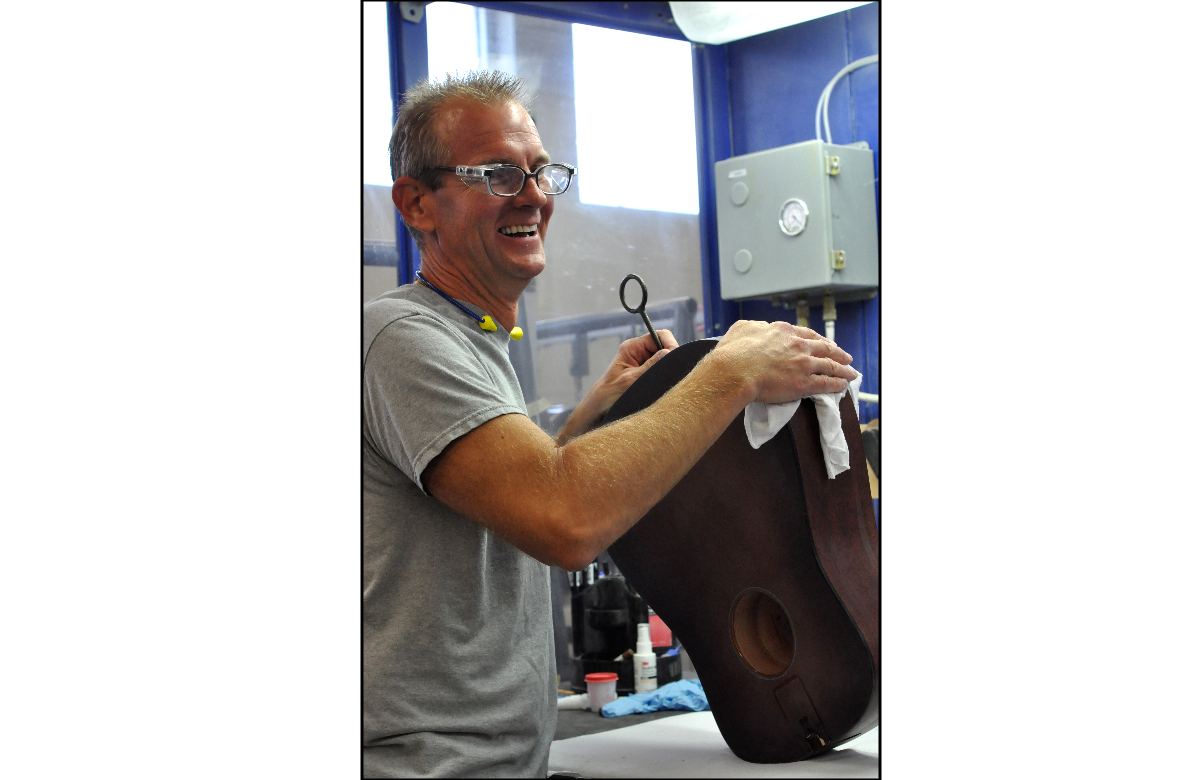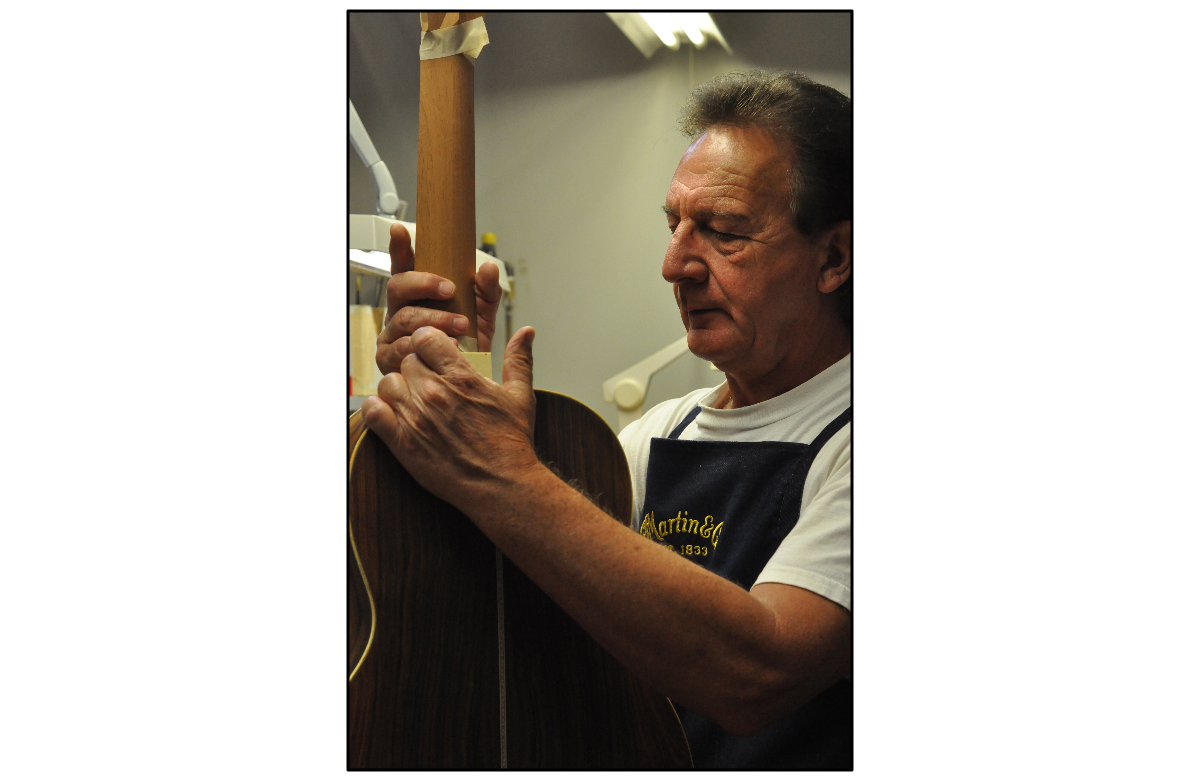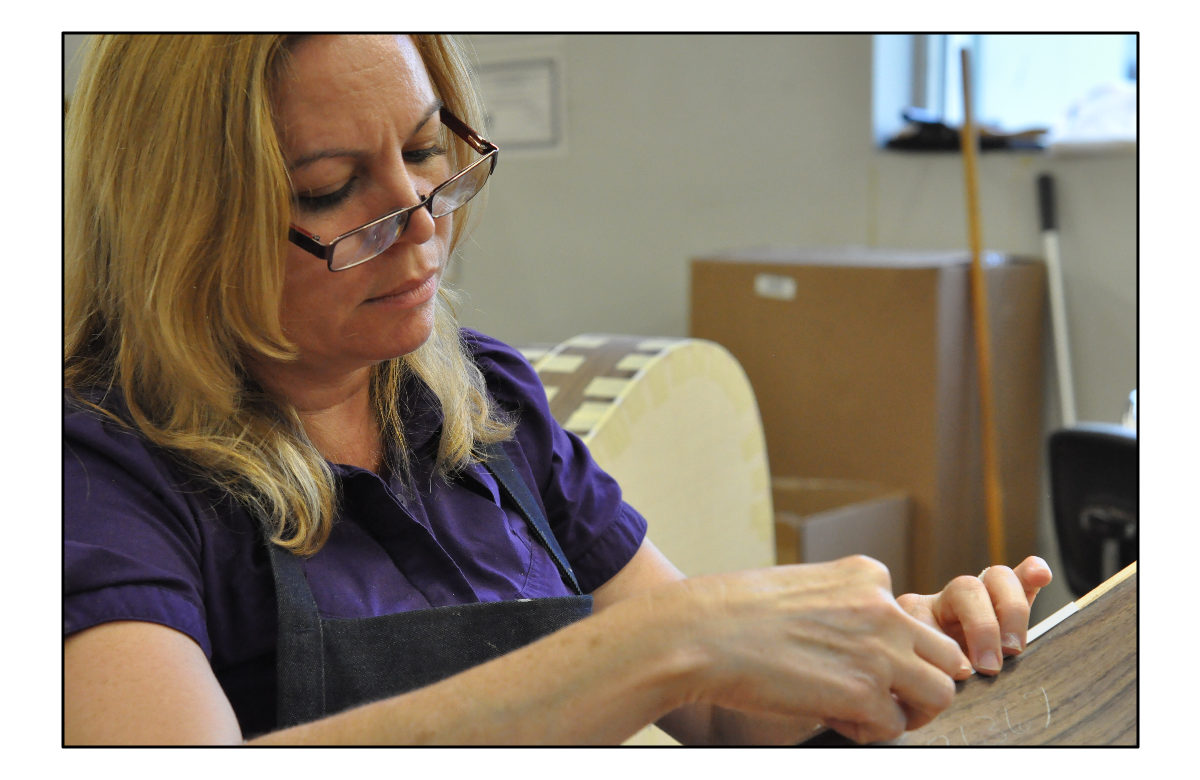Order the Martin Custom Shop Guitar of Your Dreams - Part 2 – Advanced Specifications
In Part 1 of our series on designing your personal Martin Custom Shop guitar, we looked at the key elements of Neck Shape, Body Size, and Instrument Style.
In Part 2 we will focus on specific options that can add up to making your custom Martin truly one of a kind. These will include the type, size, and position of the bracing; the kind of glue used to construct the guitar; the kind of finish used on the body, and the neck; the kind of reinforcement used inside the neck; and various options relating to the cosmetic appearance of the completed custom Martin.
We begin by delving down inside the guitar, to take a look at the braces.

Bracing – a top priority
The customizable elements of top bracing consist of the specific shaping of the braces, the width of the braces, the position of the main X brace, and the species of spruce used for the bracing.
The choices for the brace shaping are non-scalloped braces, as used on the Standard D-28, D-35, and most of the 15 Series Martins; scalloped braces, used on most modern Martins like the HD-28, the OMC-16E, and 000-18; and Golden Era scalloped braces, currently found on the instruments of the Modern Deluxe Series.
“Scalloped bracing” means that a craftsperson used a chisel to carve out “scallops” to make each brace more flexible. The more flexible the bracing, the more responsive the top is to lighter picking and harder strumming.
Non-scalloped bracing was prevalent in the 1950s and 1960s, and provides finely honed definition, most noticeable in the bass register. The fundamental notes off the six strings project with a pronounced punch and individual distinction.
Scalloped bracing provides more echoing body resonance and a rounder, thicker bottom end compared to the focused bass fundamentals heard from non-scalloped braces. For large guitars like Dreadnoughts, it is very much a matter of personal taste when it comes to scalloped vs. non-scalloped bracing. But it is generally accepted that scalloped bracing is a welcome enhancement to the tone of guitars with smaller bodies, like OMs, 000s, and 00s. And then there is the matter of how much scalloping there should be.
With Golden Era scalloping the craftsperson uses the hand chisel to remove more wood from the braces than in standard scalloping, for deeper scallops and steeper angles to the peaks along each tone bar. So, the voice is even more resonant, with an open, airy quality behind the main fundamentals. This option is the closest thing to Martin bracing from the 1930s that is available for custom order.
When it comes to the size of the braces, all Dreadnought models have 5/16” bracing, except for the D-35 and HD-35, which have 1/4" bracing found on smaller Martins like OMs and 00s. Like scalloping, the width of the braces relates to top flexibility, and therefore how responsive and resonant the voice will be. But each has its own effect.
If you like big round bass and tightly focused trebles of the D-35, 1/4" braces may be the way to go. If you want that sound supercharged, than add the scalloping of the HD-35. But if you prefer the overall fullness of the D-28, HD-28, D-42, et al, then 5/16” is the way to go.
Martin has even made guitars with a 5/16” X brace and 1/4" tone bars, like their original 14-fret guitars of the early 1930s. And that might just be a happy medium between the two kinds of dreadnought sound.
The position of the X brace, in relation to how far it was placed from the bridge plate, evolved over time. But we tend to mention this in terms of how close it is to the sound hole because it is easier to see, or even feel with your finger, if you put it inside the guitar. But the farther the center of the X brace is from the bridge plate, where most of the string energy is transferred to the body, the more flexibility there is.
Guitars with the original position used on 14-fret Martins of the 1930s is now called Forward-Shifted bracing, because they moved that position closer to the bridge plate in 1939. That later position is now known as Rear-Shifted bracing. Forward-shifted bracing has the X brace about 1” from the sound hole. Rear-shifted bracing is about 1-7/8” from the sound hole.
In 1960, the position was moved in-between the two, to about 1-1/2” from the X brace. This was considered the standard bracing until Martin reimagined the Standard Series in 2018, and Forward-Shifted bracing became the new standard.
But what does this mean in terms of tone? The easy answer is “bass response.”
Forward-shifted bracing provides fuller, deeper, rounder bass tone. This does not mean the other two options don’t have lots of bass; they do. But the top notes are not as “fat” and there is not as much body resonance surrounding them. The rear-shifted bracing guitars of the past have great clarity and definition. The old timers with the forward-shifted braces have that almost-super-natural depth and open expansive quality, and greater bass boom. Add to this equation the effect of scalloped braces vs. non-scalloped, and the width of the braces in question, and the physics begins to seem like alchemy, if not wizardry.
Each one of these elements matter, but it is their combination that provides the final result. If you are not intimately familiar with Martins of all sorts, from various eras, we suggest you equate yourself with the various Martin models available today, in person, or via our many excellent demonstration videos.
Find the ones with the voices you like, and see what kind of bracing they have. Keep that in mind for when it is time to design your special Martin. But be sure to ask if you have any questions or wish to seek knowledgeable opinions about what certain combinations of brace size, shape, and position might have on your end result. It can matter as much as the species of tonewoods you choose for your back, sides, and top.
And with that, we will mention the species of spruce used for the braces matters too. Sitka has a good balance of strength and flexibility. Adirondack is notably stiffer. Your choice might best be based on the wood you are using for your top. Softer spruces like Engelmann and European species have a lovely tonal glow about them, but they can be overdriven easier when under powerful strumming. If a mighty attack is a big part of your music making, such a top might benefit from Adirondack bracing.
If you are mostly interested in nuanced fingerstyle and basic pick and strum vocal accompaniment, Sitka would be the better choice. And if you are playing fingerstyle exclusively, but like the clarity and harmonic transparency of Adirondack spruce tops, you might consider Sitka bracing to help with the responsiveness, as that Adi top slowly breaks in over the next few years.
Glue – a sticky business
Unlike the braces, the glue used to affix them to the soundboard comes in only two varieties. Martin has been using modern wood glues since 1965. But they also offer traditional animal hide glue, just like the stuff used by C. F. Martin Sr. and his many decendents up into twentieth century.
Reintroduced for the first Authentic Series guitars, hide glue requires a rather sticky situation, as it were. It takes a lot of extra time, as it must be heated in a glue pot before use and cooled down before storage in a refrigerator. It is also more difficult to work with and has a short shelf life. But it was always rumored to actually make guitars sound better.
Modern science has proven that it has a unique way of sinking down into wood fibers better than synthetic glues, to create a deeper, more even bond between the two pieces of wood – be that the neck joint and neck block, the bracing and the top, or any other joinery involved in the construction of a Martin guitar. And that suggests superior energy transference as the physical energy that eventually turns into soundwaves makes its way from one part of the guitar to the next.
But does it actually have an influence on tone? Well, C. F. Martin IV assumed it did not, until they started experimenting for the first D-18 Authentic model. After blind sound tests, he became convinced it did have an impact on tone for the better, if a subtle one. Is that difference in tone worth it to you? Only you can say. But if you want your guitar to be more like the Martins made in the 1930s and ‘40s, hide glue is a no brainer.

Finish
Martin’s Thin Finish Package is one feature of the Authentic Series instruments that definitely has noticeable impact upon the tone of a guitar. Martin uses natural, high gloss, nitrocellulose lacquer for nearly all of their professional-level instruments. Others, like the 15 Series, have a satin finish of a similar composition. And they have always worked to achieve a balance between protecting the wood and having a finish that is thin enough that the tonewood can “breathe” and respond to string vibration as much as possible.
A few years back, they perfected the ability to put the high gloss nitro lacquer on a new guitar, with the thickness of a vintage Martin finish that had thinned out over the decades, allowing it to respond and resonant tremendously. At first, this feature was only sold on the Authentic Series instruments, but not anymore.
Now available for custom orders, the Thin Finish Package allows a guitar to be even more resonant and responsive than their normal nitro finish. It is required to truly get the most tone out of your custom Martin. However, it comes with the caveat that it is not as protective as Martin’s normal finish. The wood “bruises” easier when knocking into a chair or belt buckle, etc., and the finish itself scratches easier.
In other words, the Thin Finish Package is not recommended for someone who is going to fret over finish dings more than they will be fretting the strings to make them sing as gloriously as possible. But if you are all about tone, or are trying to make your custom guitar as much like a pre-war Martin as possible, you should seriously consider this option.
Take it from our friend Spoon Phillips, who said, “Laurence (Juber) and I were discussing and comparing the separate Guatemalan rosewood Martins we were about to order, when he told me how happy he was with the tonal enhancement from the thin finish on his koa signature model. He was including it on his new Custom Shop limited edition, like he had already done on another custom Martin he had made out of mahogany. That endorsement was good enough for me, and I couldn’t be happier with the results. Even if it dings easier than the normal finish, I’ll never order another custom Martin without getting the Thin Finish Package.”
Speaking of finishes, the normal high gloss finish can be ordered on guitars that normally come with satin finish, like the various models in the 15-Series, or models that normally come with only a high-gloss top. And since only Martins made in Style 41, 42, and 45 get a high gloss finish on the neck, you might want consider that as an upgrade option if your starter model is an 18, 28, or 35, which come standard with a satin finish on the neck.
Neck Reinforcement – the straight and the light of weight
Martin’s modern two-way adjustable truss rod provides secure reinforcement against the years of taught string tension. But even here there are customizations available.
If you are looking for a custom guitar made more like Martins from bygone eras, you can order your vintage V neck with a vintage T bar, which is non-adjustable but is considered an element involved in achieving genuine vintage Martin tone. For that matter, you can get an ebony rod, like they used in the earliest OMs and the Martins from before they invented the 14-fret guitar.

None of these vintage reinforcement options are available for the thinner modern neck shapes, like the Low Profile and the Modified Low Oval used on Martin’s standard High Performance Neck. But there are futuristic options available, which are lighter in weight than the usual Martin neck rod: the carbon fiber neck rod and the titanium alloy neck rod.
The adjustable titanium alloy rod found in the Modern Deluxe models and some limited editions will make any guitar feel like a vintage Martin when it comes to the weight distribution between the neck and body. And the carbon fiber rod, while non-adjustable, is more ridged than steel, but weighs even less than the wood it displaces inside the neck! It provides the lighter-than air feel of a pre-war OM, but couldn’t be stronger.
If you are looking for an ultra-light fingerstyle instrument of the utmost sensitivity and responsiveness, the combination of the Thin Finish Package and one of these low-weight neck rods is well worth considering. And while you are at it, you might want to imagine that very special neck adorned with binding that covers the fret ends and ads a look of distinction seen in top shelf Martins like the D-45 and OM-42.
Binding and Purfling – tasteful trimmings
Martin’s traditional instrument styles include a combination of cosmetic trim, which can be altered to suit your personal preferences. Mix and match, or come up with your own ideas.
Martins made with dark rosewood back and sides usually have light binding, like the Antique White variety used on the Standard Series, or the Grained Ivoroid binding used on the Authentic Series. Guitars made with mahogany or cherry often have binding of faux tortoise color. But you can also order the plain white binding used on older Martins, as well as pure black binding. And if you are a lover of beautiful wood, why not go all out and order your custom Martin with wooden binding?
There are many choices when it comes to wooden binding. Indian rosewood, Madagascar rosewood, and flamed maple are among the most popular options. And then there is figured koa and ovangkol, which look awesome as well.

And speaking of all wooden trim, you can also order wood fiber purfling to be inlaid around the top and sound hole, rather than the normal plastics used these days. Wood fiber purfling is made out of maple, and dyed black as necessary. It has a mellow golden hue rather than stark white, and it ages right along with the top as the years go by. This is yet another option for the guitarist who is trying to design their guitar of a lifetime to be more like a pre-war Martin than not, or for someone who simply loves wood and wants as much of their guitar made from wood as possible.
In terms of purfling designs, first, there are the classic varieties. The herringbone trim seen on Style 28 that dates from the 1800s, that design and the various black and white ply striping that arose in the Art Deco motifs from the Jazz Age have been copied the world over, because they look so great. But the differences are in the details. Be sure and look closely at the top trim and the sound hole rosettes on the various Martin models, to see which ones are your favorites. Some have more layers or lines, and even the herringbone can be bold or not so bold.
For another option, take a look at Style 30 purfling, which is an intricate marquetry made of brightly colored wood, with green, red, blue and natural maple tone for the yellow. We find it absolutely gorgeous! You will have to look up some extinct models like the OM-30DB Paul Donohue model or the M-30 Jorma Kaukonen, but it is worth it. For that matter it makes an excellent back strip purfling as well. And where the back is concerned, you have the option of no back strip, the thin black line of Style 18, the checkered marquetry of Style 28, the Zig-zag back strip of Vintage Style 28, and the complex and colorful marquetry of Style 45.
And all of this is without even mentioning the fancier inlay available from the Custom Shop, made from wood, naturally luminescent sea shells, and other materials. But for that, you must wait for Part 3 of our series on the right way to design your very own custom Martin guitar.